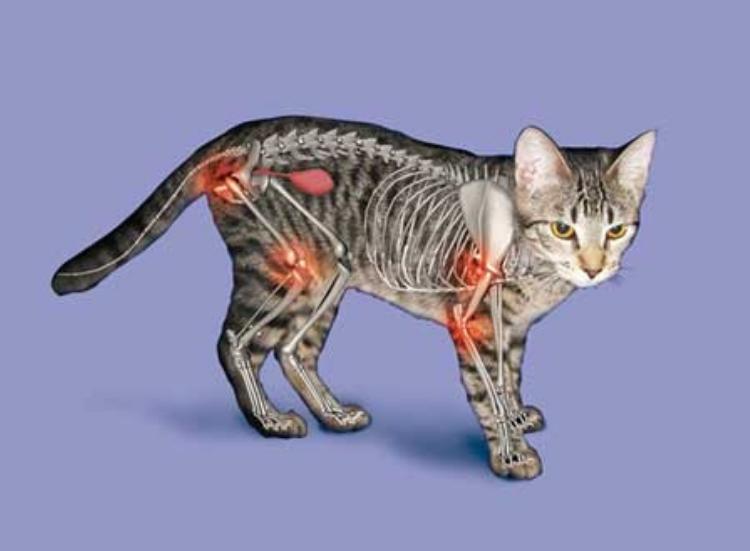Managing Arthritis in Cats: Understanding, Detecting, and Providing Relief


Arthritis
For most veterinarians, arthritis is a familiar problem. Cats receiving arthritis diagnoses is on the rise. Simply said, arthritis is an inflammation of the joints, and animals who have it typically experience joint pain and stiffness. Older pets are usually more affected by arthritis. However, if joint development issues are the origin of the arthritis, many affected animals will have displayed early illness symptoms.

What is arthritis?
A thin layer of smooth cartilage covers the bone surfaces in a typical joint. A tiny bit of joint fluid is used to lubricate this. The joint's two sides can easily slide over one another thanks to this arrangement. Animals who suffer from arthritis, sometimes referred to as osteoarthritis, experience degeneration, damage, and thinning cartilage in their joints. Instead of gliding, the bone surfaces start to rub against one another, which is painful and progressively damages the cartilage. Over time, the formation of new bone surrounding a joint may result in stiffness and restriction of joint movement. Arthritis can affect one joint or many, depending on what causes it.
What causes arthritis?
Most often, aberrant joint wear is the cause of arthritis development. This could result from:
-
Age: Older cats are more prone to arthritis due to the natural wear and tear on their joints over time.
-
Genetics: Some cat breeds are genetically predisposed to arthritis, such as Maine Coons and Persians.
-
Injury: Joint injuries or trauma, especially if not treated properly, can lead to arthritis later in life.
-
Obesity: Excess body weight puts added stress on joints, increasing the risk of arthritis.
-
Infections: Joint infections, such as those caused by tick-borne diseases, can contribute to the development of arthritis.
How would I know if my pet had arthritis?
Joint pain and stiffness are symptoms of arthritis. If your pet has arthritis, you may notice that they appear stiff or limp, and that they are not as eager to exercise as they used to be (especially when they wake up from sleep). Walking may help with this stiffness, although occasionally the signs may worsen due to cold and/or damp conditions.Occasionally, animals with pale coats may lick their sore joints repeatedly, causing the fur near the affected joint to become darker due to the salivary glands. Although the joint may occasionally seem hot or swollen, most of the time you won't be able to notice any changes to the joint. Certain animals may exhibit highly visible symptoms of discomfort, while other dogs may just become quieter or more irritable.
Signs and Symptoms
-
Reduced Mobility: Cats with arthritis may have difficulty jumping, climbing, or running. They might be less active than usual.
-
Stiffness and Limping: Arthritic cats often show signs of stiffness, especially after waking up or resting for a while. Limping or favoring certain limbs is common.
-
Changes in Grooming Habits: Cats in pain may struggle to groom themselves properly, leading to a unkempt appearance.
-
Behavioral Changes: Cats with arthritis may become irritable, withdrawn, or aggressive due to discomfort.
-
Reluctance to Be Touched: Cats may react negatively when specific joints are touched due to pain.
How will my vet know if my pet has arthritis?
The symptoms you mention may lead your veterinarian to believe that your pet has arthritis. Your veterinarian should be able to determine which joints are uncomfortable, stiff, or swollen by looking at your pet's legs. Your veterinarian might need to undertake additional testing to learn more about the condition of the joint. Joint X-rays can be used to determine any underlying causes of arthritis as well as to confirm its existence. A tiny sample of fluid from inside the joint may also be taken for study by your veterinarian. Blood samples may occasionally be needed in order to screen for diseases that could harm the joints. In order to determine the cause, your veterinarian will want to obtain samples if they believe the joint is infected.
Is there any treatment for arthritis?
The underlying etiology and the affected joint(s) determine the course of treatment for arthritis. Almost always, arthritis is worse in overweight and unfit animals. The goals of osteoarthritis treatment must be to minimize pain, prolong the life of the joint's structures, and maintain joint function. The combination of weight control and activity management, which minimizes the strain on the joint and maximizes range of motion and muscle fitness surrounding the joint, is unquestionably the most significant therapy for individuals with osteoarthritis.
For a few weeks or months, medication therapy will also benefit a lot of people, and occasionally, long-term medication therapy will be helpful. First and foremost, pain management is crucial, and non-steroidal anti-inflammatory medications (NSAIDs) are the most often prescribed veterinary analgesics.
Your pet may require multiple treatments from your veterinarian if they have arthritis throughout their lifetime. The course of treatment will change over time for each patient as well as from one to the next. For each patient, the greatest immediate and long-term care may involve utilizing many therapies, either separately or more frequently in combination, according to your veterinarian.
Supportive Care for Cats with Arthritis
-
Consultation with a Veterinarian: If you suspect your cat has arthritis, consult a veterinarian for a proper diagnosis. They can perform a physical examination and may recommend X-rays or other tests to confirm the condition.
-
Pain Management: Veterinarians can prescribe pain medications or anti-inflammatory drugs tailored to your cat's needs. These medications help manage pain and improve the cat's quality of life.
-
Weight Management: Maintaining a healthy weight is crucial for arthritic cats. Consult your vet for a suitable diet plan to help your cat achieve and maintain a healthy weight.
-
Joint Supplements: Omega-3 fatty acids and glucosamine supplements can support joint health. Your veterinarian can recommend appropriate supplements and dosages.
-
Comfortable Environment: Provide soft and warm bedding, as well as easy access to food, water, and litter boxes. Consider using ramps or steps to help your cat reach elevated surfaces.
-
Low-Impact Exercise: Encourage gentle, low-impact exercises to keep joints flexible. Interactive play sessions and toys that encourage movement can be beneficial.
-
Regular Veterinary Check-ups: Schedule regular check-ups to monitor your cat's condition and adjust the treatment plan as necessary.
-
Alternative Therapies: Some cats benefit from acupuncture, physical therapy, or chiropractic care. Consult your veterinarian to explore these options.
What drugs are used to treat arthritis?
Chondroprotectants
It makes sense to attempt to minimize cartilage degradation because it plays such a significant role in arthritis. Some medications are referred to be chondroprotective medications because they may lessen cartilage damage. It is hypothesized that medications such hyaluronic acid, polysulphated glycosaminoglycans, and pentosan polysulphate reduce inflammation, encourage joint structure repair, and lessen cartilage degradation. Sadly, not all of these medications are approved for use in cats and dogs, and some need injections into the joint.
The use of so-called nutraceuticals has increased recently. These are the components of cartilage, especially glucosamine and chondroitin sulphate. By including nutraceuticals in the diet, arthritic symptoms may be lessened since they may supply the building blocks for cartilage regeneration in the joint. Nutraceuticals have been used to treat long-term osteoarthritis in humans, and in animals, they might be a helpful supplement to other forms of treatment.
Non-steroidal anti-inflammatory drugs (NSAIDs)
NSAIDs are frequently given to treat arthritis because of their dual effects on pain and inflammation. In addition to other side effects, some medications occasionally cause vomiting or diarrhea. There are various cautions against its long-term usage in dogs due to these negative effects. Since NSAIDs can be more hazardous to cats, their usage is strictly prohibited.
The medications with the greatest effects on inflammation and analgesia are probably the first choices in the short term. Due to the cumulative risk of adverse effects, these medications are frequently not needed in the medium or long term and are not authorized for such use. Alternatives must be looked for in these situations, especially with cats where the therapeutic options are more constrained. As new medications become available, it's important to regularly assess the patient's progress and current medication regimen in order to build an effective management strategy for arthritis.
Will my cat get better?
Sadly, joint cartilage seldom heals itself once it has been injured. Even so, many pets can be kept pain-free with long-term drug use and treatment to prevent further joint wear and tear, even though there may still be damage to the joint.
The degree of arthritis varies greatly throughout individuals. Many animals with illnesses manage well and have long, active lives without the need for medical care. Some people need care that ranges from straightforward lifestyle adjustments to intricate surgery. Arthritis symptoms can change over the course of an animal's life and frequently lead to the early start of joint issues in old age.
Conclusion
Arthritis in cats is a manageable condition with proper care and attention. By being attentive to your cat's behavior, seeking veterinary care when needed, and providing the necessary support, you can help your feline companion live a comfortable and fulfilling life despite arthritis. With love, patience, and appropriate medical care, cats with arthritis can continue to enjoy their lives to the fullest.




